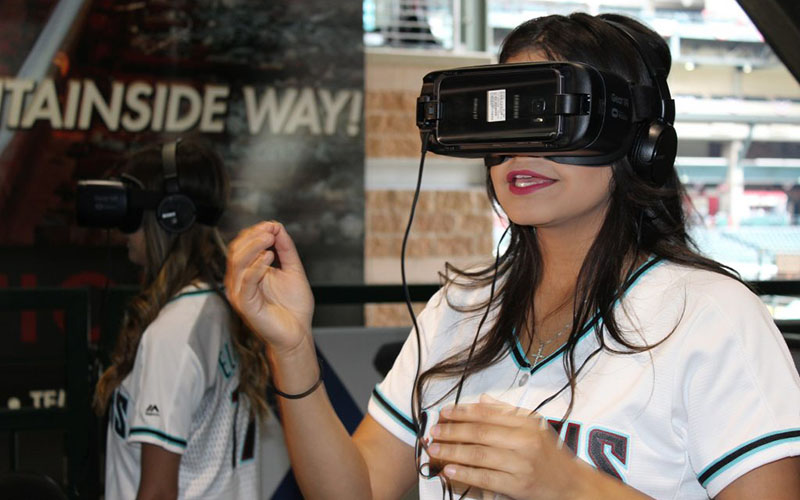
The COVID-19 pandemic has made sports network executives look harder at how virtual reality could impact the way we watch games and the way we play them. (Photo by Chesnot/Getty Images)

Virtual reality will likely be a bigger factor in the fan experience in the future. Here Arizona Diamondbacks employee Sienna Villa tries out a virtual reality headset in the Cox Connects VR Bullpen at Chase Field. (Photo by Samantha Pell/Cronkite News)
PHOENIX – With the sports world at a standstill during the COVID-19 pandemic, one platform may change how fans take in sports for years to come.
Virtual reality could serve as a way to provide fans with experiences previously thought only possible at in-person events.
During the first session of a two-part virtual conference called World Comes to Congress, sports media executives spoke about the spread of the new coronavirus and how it continues to shape our media landscape.
Irwin Kisner, the executive chairman of Herrick Sports Law Group, said this may be the optimal time to capitalize on virtual reality.
“How will (virtual reality) evolve in the future?” Kisner asked. “I think people will have the capability to go into their own room and watch these contests as if they are there. It promotes a safer environment and they may be able to still feel like they are there.”
Even when sporting events resume, Kisner said, there is a chance fewer fans, or even no fans at all, will be allowed to attend games and matches. Because of this, technology could help replicate the in-game atmosphere for fans.
The market for augmented reality (AR) and virtual reality (VR) products are predicted to end the year with growth of 23 percent globally, according to the Worldwide Quarterly Augmented and Virtual Reality Headset Tracker.
While digital media continues to advance and be used at high volumes, virtual reality may have the best opportunity to succeed right now.
“Digital transformation in the workplace is edging towards an inflection point as enterprises are incorporating immersive solutions that connect the real world with the virtual world,” Maria Pardee, Tysons, Va.-based DXC Technology senior vice president and general manager for workplace and mobility, said in a statement to CMSWire.com. “We’re using the power of AR, VR and MR (mixed reality) to align the next-generation digital capabilities employees want so they can be more mobile and independent, with the critical security, production prowess and agility that today’s businesses demand.”
Virtual reality can also potentially enhance esports and the way video game enthusiasts consume and interact with live games.
Through VR as well as live-streaming, gamers are able to watch esports competitions while wearing VR goggles and communicating with other viewers, the commentators and sometimes even the professional gamers through text-chatting.
As younger groups of sports fans are much more connected to the digital world than previous generations, traditional sports leagues are starting to pay attention to the increasing popularity and options VR provides.
“Sports is grappling with an audience under 30 that’s radically different than” older fans in terms of what they want out of broadcasts, John Kosner, a former executive at Walt Disney Co.’s ESPN told The Wall Street Journal.
Kosner, now an investor in sports-technology startups, believes that sports broadcasts must evolve to become “more appealing to younger fans.”
“A more immersive experience around sports is definitely coming,” Kosner said.
ESPN president Jimmy Pitaro said during World Comes to Congress that sports media members should realize they are very important right now, even without live sports.
“Know at some point, journalists are helping millions of sports fans get to a happier place,” Pitaro said.
Kishner said that it is amazing how this virus has changed the entire landscape of sports media. He said the idea of having sporting events with no fans was hardly a thought before COVID-19.
“We don’t know how long this will continue,” Kishner added. “We will have to take what we’re learning each day and move forward as best we can.”
Executives also spoke about adjusting to a world without sports.
Pitaro spoke about the night of March 11, when the NBA decided to postpone its season.
“I was at my desk in my home office working honestly on our contingency plan and backup programming strategy and thinking about the possibility that things could be changing and changing quickly,” Pitaro said. “We had a discussion about how to protect our employees and our company.”
ESPN’s president described the NBA commissioner’s decision to postpone the season without being instructed to do so as “extremely smart.”
Pitaro said he was proud of the professionalism the leading faces of his company displayed in this time of extreme uncertainty for sports journalists.
“It’s important to stay calm,” Pitaro said when asked what advice he had for the rest of the sports journalism industry. “Take care of families and colleagues. Know, at some point you, as a journalist are helping millions of sports fans get to a happier place.”
Scott O’Neil, President and CEO of Harris Blitzer Sports and Entertainment, had a similar sentiment, saying that although journalists have a job to do, humans still have a responsibility to halt the spread of the coronavirus as much as possible.
“Stay inside, keep your family inside,” O’Neil said. “We have to do our part in stopping this madness.”
O’Neil said journalists like the general public need to be more prudent than ever. But journalists also have to realize how important they are to society at this time.
“It’s our time, let’s go lead,” O’Neil said. “We talk about preparation quite a bit. Companies need to have work protocols for being home, communication protocols and emergency planning. We can’t stop working but have to do it in different ways.”
